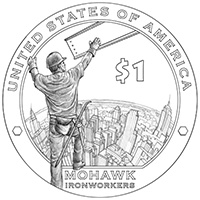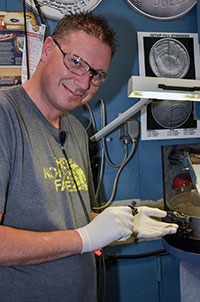By Sharon McPike
January 14, 2015

The 2015 Native American $1 Coin reverse commemorates the contributions of the Kahnawake Mohawk and Mohawk Akwesasne communities to “high iron” construction work.
If you have ever seen an ironworker stride in the open air across a steel beam less than a foot wide on a top floor of a skyscraper under construction, you know why ironworking is one of the proudest of the construction crafts. The high-flying tradition has produced some of the world’s most impressive and mammoth structures – bridges, skyscrapers, towers and dams.
According to the Journal of American Indian Education, American Indian tribes have always valued and honored physical bravery, and modern-day bravery by tribal members is most dramatically displayed in high iron construction work on the tallest skyscrapers and in fire jumping to control raging wildfires. These occupations receive the honors formerly reserved for warriors in battle because they carry on the ancient ethic of putting one’s life on the line to advance the well-being and safety of the people.
Transforming the New York City Skyline
The tradition of Mohawks working in high iron dates back to 1886, when the Dominion Bridge Company constructed a railway bridge over the St. Lawrence River near the Kahnawake Mohawk community. Mohawks were first employed as day laborers on the project, but they displayed the balance and fearlessness necessary for working on the high ironworks of the bridge itself, and they amazed their supervisors and co-workers with their ability to handle heights. After that first bridge project, Mohawk ironworkers from the Canadian and United States sides of the St. Lawrence River began traveling to New York City to do high work on skyscrapers and bridges that eventually transformed the New York City skyline. They were integral to the creation of the Empire State Building, George Washington Bridge, Chrysler Building, United Nations Building and the World Trade Center. They traveled west to build the Sears Tower in Chicago, the Golden Gate Bridge in San Francisco, and the Lions Gate Bridge in Vancouver. In September 2001, after the fall of the World Trade Center Towers, the sons and nephews of the ironworkers who built the World Trade Center returned to the site to dismantle what their elders had helped to build.
The danger of the work at the beginning of the 20th century was brought home in 1907 at the Quebec Bridge project, designed to be the largest cantilevered bridge in the world. On Aug. 29, the structure failed and the bridge collapsed into the river, killing 33 Mohawk workers. After the disaster, the Kahnawake Clan Mothers ruled that large numbers of Mohawk men could not work on the same project at the same time.
The tradition of high iron work entered a new and poignant phase after the Sept. 11, 2001 attacks on the World Trade Center. Dozens of Mohawk ironworkers volunteered for the dangerous job of removing debris. The St. Regis Reservation Tribal Council – the government for the U. S. side of the Mohawk Akwesasne community that straddles the Canada/U.S. border – and the local iron workers collected respirators to donate to the New York City Fire Department working at the 9-11 site. The venerated 9-11 flag displayed at the 2002 Winter Olympics was recovered from the lobby of Six World Trade Center by a Mohawk worker from Akwesasne the day after the terrorist attack.
The Design
The reverse design of the 2015 Native American $1 Coin depicts a Mohawk ironworker reaching for an I-beam that is swinging into position, rivets on the left and right side of the border, and a high elevation view of the city skyline in the background. The reverse was designed and sculpted by Artistic Infusion Program Artist Ronald D. Sanders and engraved by Mint sculptor-engraver Phebe Hemphill. Native American $1 Coins are manufactured in Philadelphia, Denver and San Francisco (proof).
Behind the Scenes at the Denver Mint
Alan Thompson, metal forming machine operator supervisor, inspects the Native American $1 Coin. Thompson said one of the most exciting aspects of his job is bringing the unique elements of each coin design to life. The production requires creative problem-solving, such as adjusting the amount of tonnage used to strike the coins to managing die life.

See more Inside the Mint articles


